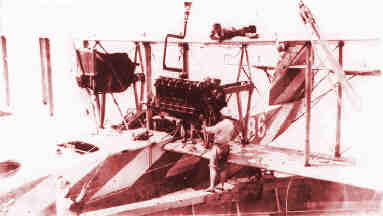 |
AIRCRAFTOF THEA E F |
Curtiss F-5-L
Flying Boat

Development and OperationThe Model F-5-L flying boat resulted from the evolutionary growth and design interplay between the Curtiss Co. and the British Royal Naval Air Service. The F-5-L traces its origins back to the original Curtiss `America' Flying Boat being designed for the planned transatlantic crossing of 1914. Lt. Cyril Porte, formerly of the RNAS, was involved in the design of the planed machine. When the war broke out Porte returned to England and rejoined the RNAS. In his new capacity he helped to develop improvements in the Curtiss Flying Boats which made them more suitable for military operations over the North Sea. These changes resulted in the H-12 and H-16 aircraft supplied by Curtiss and eventually the F series of flying boats, which were built in England. The principle design changes related to improvements in the configuration of the hull. For the initial F series of Flying Boats the wings, empennage, and power plant were essentially of Curtiss design. For the F.5 model the power plant was changed to the 345 hp Rolls-Royce engine. However, when the machine was built at the U.S. Naval Aircraft Factory in Philadelphia it was redesigned to use the Liberty engine; hence the designation of F-5-L. The F-5-L was flown by U.S. Navy pilots both at naval air stations in England as well as in France. |
Aircraft and Flight Characteristics
|
Span |
103 ft. 9 in. |
|
Length |
49 ft. 3 3/4 in. |
|
Height |
18 ft. 9 1/4 in. |
|
Empty Weight |
8,720 lbs. |
|
Gross Weight |
13,600 lbs. |
|
Maximum Speed |
90 mph |
|
Climb to 2200 ft. |
10 minutes |
|
Ceiling |
5500 ft. |
|
Armament |
6-8 machine guns plus four 230 lb. bombs |
|
Crew |
4 |
References:
- Bowers, Peter, Curtiss Aircraft, 1907-1947
- Photo from the author.
To find other Doughboy Features visit our |
Membership Information  Click on Icon |
For further information on the events of 1914-1918
visit the homepage of |
Michael E. Hanlon (medwardh@hotmail.com) regarding content,
or toMike Iavarone (mikei01@execpc.com) regarding form and function.
Original artwork & copy; © 1998-2000, The Great War Society